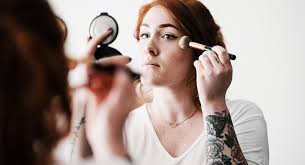When pregnant women use cosmetics containing parabens, their children may have a greater likelihood of becoming overweight, a new study suggests.
Parabens are chemicals that have long been used as a preservative in cosmetics and body care products. A number of studies have suggested that parabens mimic estrogens in the body and may disrupt the normal function of hormones.
In the new study, researchers found detectable parabens in the urine of pregnant women who used paraben-containing “leave-on” products every day—makeup, body lotion or facial moisturizers.
The higher those urinary paraben levels, the more likely it was that a woman’s child would be overweight by age 8.
A compound called butylparaben stood out: Kids were twice as likely to be overweight when their mothers’ prenatal levels of butylparaben were in the top one-third, compared to the bottom third. Girls, it seemed, were more affected than boys.
The findings do not prove that parabens are to blame, said researcher Irina Lehmann of the Berlin Institute of Health and Charite at Berlin University Hospital in Germany.
Many factors, she said, contribute to excessive weight gain—including lack of exercise and too many calories.
But this is not the first study to link prenatal exposure to endocrine-disrupting chemicals and kids’ odds of being overweight, said Eva Tanner, a researcher at Mount Sinai’s Icahn School of Medicine in New York City who reviewed the findings.
“This work adds to the growing body of evidence suggesting that prenatal exposure to chemicals found in common consumer products may harm child growth and development,” Tanner said.
She praised the study’s design as “exceptional.”
That’s because along with studying mother-child pairs, researchers looked for more direct evidence by conducting experiments in lab mice: They exposed pregnant mice to butylparaben, at amounts comparable to those of women with the highest urinary levels of the chemical.
In the end, the female offspring of those mice gained more body fat, compared to mice whose mothers were not exposed to butylparaben.
“With the animal model,” Lehmann said, “we, in fact, could demonstrate that the weight increase is caused by this paraben.”
The experiment also yielded some clues about why: Female pups born to paraben-exposed mice tended to eat more. They also showed evidence of altered activity in a gene called POMC—which helps regulate appetite.
But why would females—both human and mice—specifically be affected? The fact that butylparaben influences estrogen activity suggests a role for the hormone, according to Tobias Polte, the other lead researcher on the study.
But it’s not clear how prenatal exposure to “estrogenic” chemicals fits into the whole picture, said Polte, from the Helmholtz Center for Environmental Research-UFZ in Leipzig, Germany.
“Further studies are needed to reproduce our epidemiological findings, and bring more light into the mechanisms behind them,” Polte said.
The findings, published Feb. 11 in Nature Communications, are based on data from a larger study of 629 mother-child pairs. During the 34th week of pregnancy, the women reported on their use of paraben-containing cosmetics and gave urine samples.
Women who used leave-on makeup and lotions with parabens each day typically had higher paraben concentrations in their urine. But, Lehmann said, other sources could have contributed to those paraben levels, too; the chemicals are also used as preservatives in foods and pharmaceuticals, for example.
For now, she suggested that pregnant and breastfeeding women opt for paraben-free personal-care products. Many are labeled as such, Lehmann noted.
Tanner agreed. The chemicals stay in the body for only a short time, she pointed out. So even if women have been using paraben-containing products, they can limit their exposure at any point.
Nature Communications


